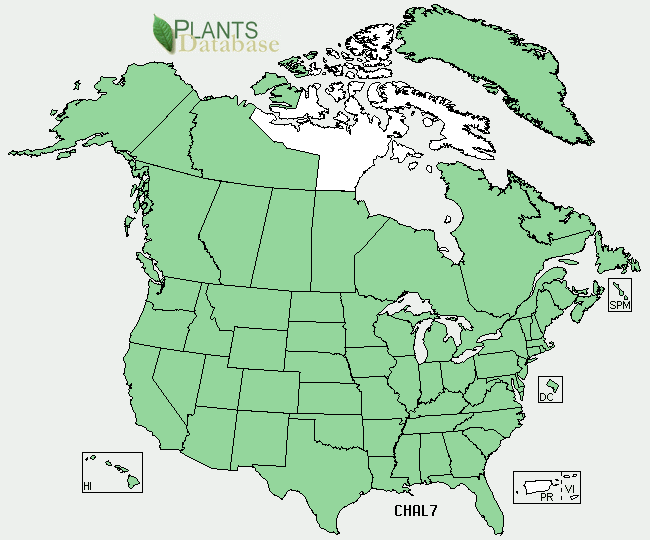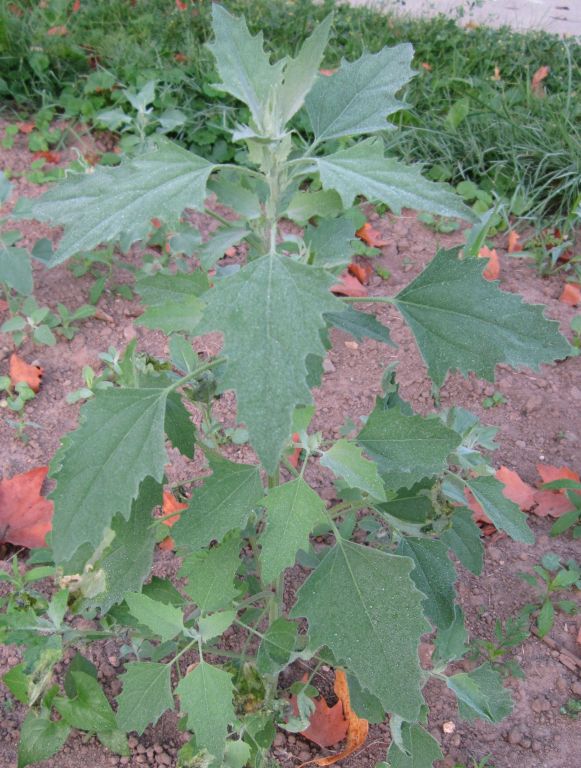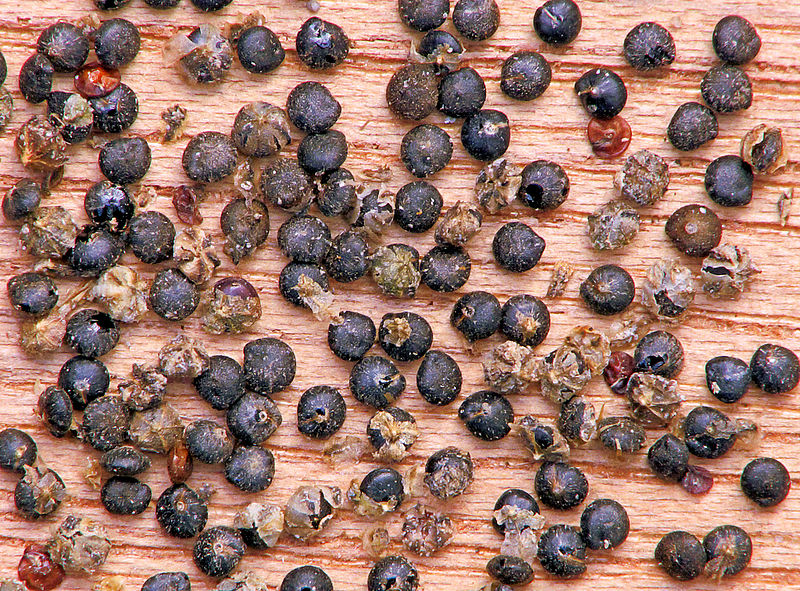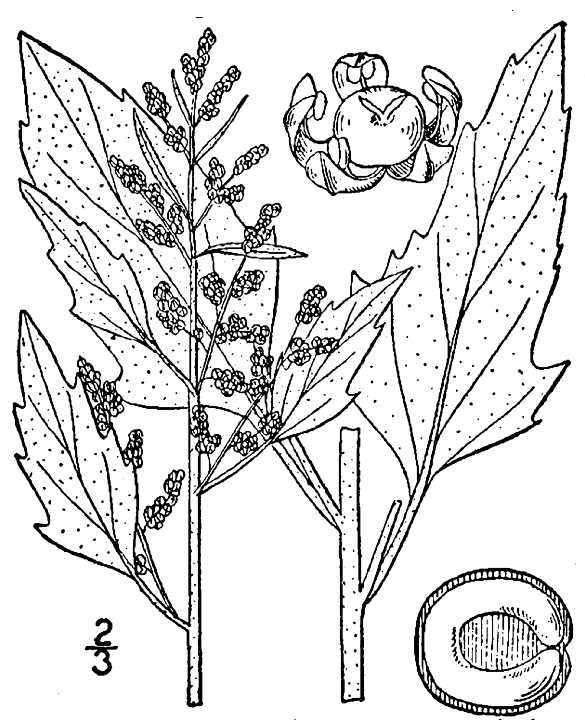Nature's Restaurant:
Fields, Forests & Wetlands Foods of Eastern North America
A Complete Wild Food Guide
Search Nature's Restaurant & Wild Foods Home Garden Websites:
Lamb's Quarters Greens & Grain

Lamb's Quarters looking straight down on it. This one is perfect for eating the top 9 or so leaves. This is a young plant with leaves that are choice for salads or cooking. Take note of the leaf shape, the plant's other name is Goose Foot.
Season: Green: Spring & Early Summer. Grain: Late Summer & Early Fall
Urban, Rural or Both: Both
Greens:
Lamb's Quarters (Chenopodium album) also called Goose Foot due to the shape of the leaves, is a close relative of spinach. Lamb's Quarters is a traditional food all around the world, and is grown as a crop food in parts of India, just as we grow spinach in the west. Use the leaves just like you would use spinach leaves.
The greens are much better on younger plants and there are two very easy ways to tell if a plant is young or mature. On young plants, all the leaves are Rhomboid (diamond) shaped with coarse sawtooth edges or margins. On older plants the upper leaves are smooth edged (Entire) and the leaves are Lanceolate to Elliptical shaped (long, narrow & coming to a point at both ends - not a sharp pointed tip in this case).
The other indicator of how mature the plant is: On young plants the stem is green while on older plants the stem is a pinkish-mauve color. See the pictures below, as this is very clear.
Grain:
Not only is it a close relative of spinach, it is also a close relative of the Quinoa, the plant that is grown for the Quinoa grain found in health food and now grocery stores.
Lamb's Quarters seeds/grain can be gathered basically the same way as described in the Amaranth section. They are easier overall, as there aren't those itchy hairs that there are with Amaranth. Since Lamb's Quarters is a close relative of the Quinoa, the grain is quite similar in taste, the big difference is that Lamb's Quarters seeds are tan to black, while the Quinoa are tan color. Cook and use just like Quinoa.
Cooking Lamb's Quarters or Quinoa grain like rice is fairly easy. Water is 2:1 ratio of the grain. So, for instance, put one cup of water in a pot, add 1/2 cup of grain, cover, bring to a boil, turn down a simmer for about 20 minutes on low. After that use just like rice. It can also be added directly to soups, added to bread by grinding in a small coffee mill or using the whole grain, or added whole to baked meals like casseroles. You don't have to pre-cook it. Make sure it is well rinsed before using.
Growing this plant in your home garden:
For detailed growing instructions, go to my Wild Foods Home Garden website Lamb's Quarters page.
Description:
- Plant Size: As tall as 3 meters (10 feet), but usually much smaller 20-100cm (8 to 40 inches) is the most common mature size I see in Southwestern Ontario
- Duration: Annual
- Leaf Shape: Varied: lower leaves on mature plants & upper leaves on young plants are Rhomboid (diamond shaped) while upper leaves on mature plants are Lanceolate to Elliptical
- Leaf Phyllotaxis (Leaf Arrangement) on branch: Alternate
- Leaf Size: Quite varied: 1-7 cm (inches) long and 0.5-6 cm (inches) wide.
- Leaf Margin: Diamond shaped leaves are toothed, upper leaf margins on mature plants are Entire (no sawtooth on edges)
- Leaf Notes: There is a white powder looking on the green leaves that is more distinct on the lower side of the leaf, but is on the upper side as well.
- Flowers: tiny 5 pointed flowers with double yellow tips
- Fruit: very small (1.5 mm diameter) tan-brown to black seeds that look like a dark color version of Quinoa grain, which is in fact a very close relative.
- Habitat: Open areas (not in shaded woods), disturbed lands, waste areas, ditches, fields, grasslands.
- Recipe search on the web here (Google search) and here (Bing search).
- Pictures on the web here (Google images) and here (Bing images).
- USDA distribution map and plant profile here.
- The Biota of North America Program (BONAP) distribution map here. BONAP map color key here.

Lamb's Quarters (Chenopodium album) range. Distribution map courtesy of U. S. Department of Agriculture (USDA Natural Resources Service) and used in accordance with their policies.

Lamb's Quarters can take many shapes and sizes. The one above is an older plant. Notice how the leaves lose their Goose Foot shape, and become smooth edged (Entire) and Lanceolate and Elliptical shaped . Note the color of the stem.

A very young Lamb's Quarters that grew in the open, and is low and wide. This one is choice for eating raw or cooking. Note the stem is green - an indication it is young.

The seed head of the Lamb's Quarters in late August with an amazing crop of Yellow Bristly Foxtail in behind. It is not ripe yet for harvesting the grain. The plant will lose its green color when ready, and it is easy to test by just shaking the seed head over some paper or a bucket. If it is ready some grain will fall out.

Lamb's Quarters (Chenopodium album) seeds/grain. This grain needs to be cleaned well before using as food. (By: Rasbak Attribution 2.0 Generic)

Lamb's Quarters drawing. (USDA-NRCS PLANTS Database / Britton, N.L., and A. Brown. 1913. An illustrated flora of the northern United States, Canada and the British Possessions. 3 vols. Charles Scribner's Sons, New York. Vol. 2: 10)
Search Nature's Restaurant & Wild Foods Home Garden Websites:
Why does this site have ads?
Originally the content in this site was a book that was sold through Amazon worldwide. However, I wanted the information to available to everyone free of charge, so I made this website. The ads on the site help cover the cost of maintaining the site and keeping it available.
Website Information:
This website was designed and written by me in HTML using the Bluefish 2.2.7 editor on Mint 18 Cinnamon Linux. I used the Bootstrap frontend framework, style sheets & Javascript.
This site is hosted by HostUpon. I am very thankful to them for all the patient technical support I received when I first set up my websites and had no idea what I was doing. I am happy to recommend them.
The site is designed to work with all browsers and is specifically designed to be highly functional on smartphones. I kept the site simple, with a clean page design to make using on a smartphone easy, quick & efficient. The Bootstrap framework is responsive, and automatically scales to any screen size.
If you encounter any problem using this site on any device, I would appreciate knowing. Let me know by using the contact page. Tell me what the problem is, and what device you are using it on.